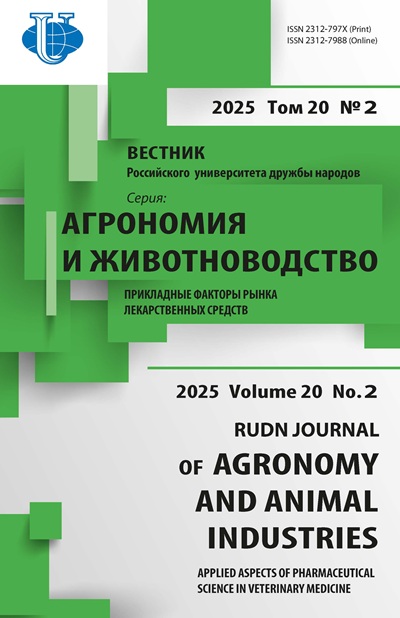Fuzzy logic device for crop analysing, modeling and forecasting in the Kabardino-Balkarian Republic
- Authors: Bischokov R.M.1
-
Affiliations:
- Kabardino-Balkarian State Agrarian University named after V.M. Kokov
- Issue: Vol 15, No 2 (2020)
- Pages: 123-133
- Section: Crop production
- URL: https://agrojournal.rudn.ru/agronomy/article/view/19560
- DOI: https://doi.org/10.22363/2312-797X-2020-15-2-123-133
- ID: 19560
Cite item
Full Text
Abstract
Using computer fuzzy-logical models based on empirical values of climatic characteristics (rainfall, temperature and humidity) of long-term observations (1955-2018) from meteorological stations in the Kabardino-Balkarian Republic (Nalchik, Baksan, Prokhladny and Terek) and crop yields (winter wheat, spring wheat, corn, sunflower, millet, oats), dependence of crop yields on variations of climatic factors were analyzed and a specific forecast was given. Setting expected values of climatic characteristics in computer model, we received possible values of productivity for the next season. Uniformity assessment (Dixon and Smirnov - Grabbsa’s criterion), stability (Student and Fischer’s criterion), statistical importance of parameters of distribution and accidental errors were determined. Originality of the method is in the fact that in the form of input parameters of the model predictors, the previously calculated forecast values of the meteorological parameters for the next agricultural year were used, and at the output, the predicted values of crop productivity were obtained as predictants. Furthermore, recommendations on adoption of management decisions were developed.
About the authors
Ruslan M. Bischokov
Kabardino-Balkarian State Agrarian University named after V.M. Kokov
Author for correspondence.
Email: rusbis@mail.ru
Candidate of Physics and Mathematics, Associate Professor, Department of Higher Mathematics and Computer Science
Nalchik, Russian FederationReferences
- Borisenkov EP. Communication of temperature and rainfall with productivity. In: Proceedings of Voeikov Main Geophysical Observatory. Issue 471. Leningrad: Gidrometeoizdat publ.; 1984; (471):46—50. (In Russ.)
- Zamyatin SA, Izmestyev VM, Vinogradov GM, Lapshin YA, Vinogradova IA. Tendention in climate change influencing agriculture. Zemledelie. 2010; (4):13—14. (In Russ.)
- Fukui H. Climatic variability and agriculture in tropical moist regions. In: Proceedings of the World Climate Conference, World Meteorological Association Report № 537. Geneva; 1979. p.426—479.
- Bischokov RM, Adzhiyeva AA, Kudayev RH, Tukova FH, Tkhaytsukhova SR. Metodika minimizatsii riska snizheniya proizvodstva produktsii sel’skogo khozyaistva [Minimization of risk of decrease in agriculture production]. Nalchik: Kabardino-Balkarian SAU publ.; 2014. (In Russ.)
- Bischokov RM. Climate features of the piedmont, steppe and mountain zones of the Kabardino-Balkarian republic in winter period. Vestnik Kurganskoj GSHA. 2018; (2):18—23. (In Russ.)
- Mirmovich EG. Forecasting of emergency situations and risks as a scientific and practical task. In: Problemy bezopasnosti pri chrezvychainykh situatsiyakh. Vypusk 1 [Security concerns at emergency situations. Issue 1]. Moscow: VINITI publ.; 2003. p.142—146. (In Russ.)
- Yudin MI, Mescherskaya AV. Some estimates of the natural components of both predictors and predictants. In: Proceedings of Voeikov Main Geophysical Observatory. Issue 273. Leningrad: Gidrometeoizdat publ.; 1972. p.3—15. (In Russ.)
- Yudin MI, Blazhevich VG, Repinskaya RP. Some questions of selection of significant predictors. In: Proceedings of Voeikov Main Geophysical Observatory. Issue 273. Leningrad: Gidrometeoizdat publ.; p.16—28. (In Russ.)
- Zadeh L. Outline of a new approach to the analysis of complex systems and decision processes. In: Matematika segodnya [Math today]. Moscow: Znanie publ.; 1974. p.5—19. (In Russ.)
- Shtovba SD. Vvedenie v teoriyu nechetkikh mnozhestv i nechetkuyu logiku [Introduction to the theory of fuzzy sets and fuzzy logic]. Available from: http://www.matlab.exponenta.ru [Accessed 26th February 2020]. (In Russ.)
- Mirmovich EG, Zharenov AB. Analyses of the decision making support problem on actions in crisis situations in conditions of uncertainty. Civil security technology. 2007; (3):82—89.
- Bischokov R, Apazhev A, Trukhachev V, Didanova E. Method of minimizing the risk of reducing the production of agricultural products by means of fuzzy logic. In: Advances in Intelligent Systems Research. International Scientific and Practical Conference «Digitization of Agriculture — Development Strategy», Vol. 167. Atlantis Press; 2019. p.401—404. doi: 10.2991/ispc-19.2019.89
- Bischokov RM, Adzhiyeva AA, Tkhaytsukhova SR. Application of fuzzy logic for risk analysis in agrarian sector. Vestnik Kurganskoj GSHA. 2014; (3):57—60.
- Waongo M, Laux P, Traore SB, Sanon M, Kunstmann H. A crop model and fuzzy rule based approach for optimizing maize planting dates in Burkina Faso, West Africa. Journal of Applied Meteorology and Climatology. 2014; 53(3):598—613. doi: 10.1175/JAMC-D-13-0116.1
Supplementary files















